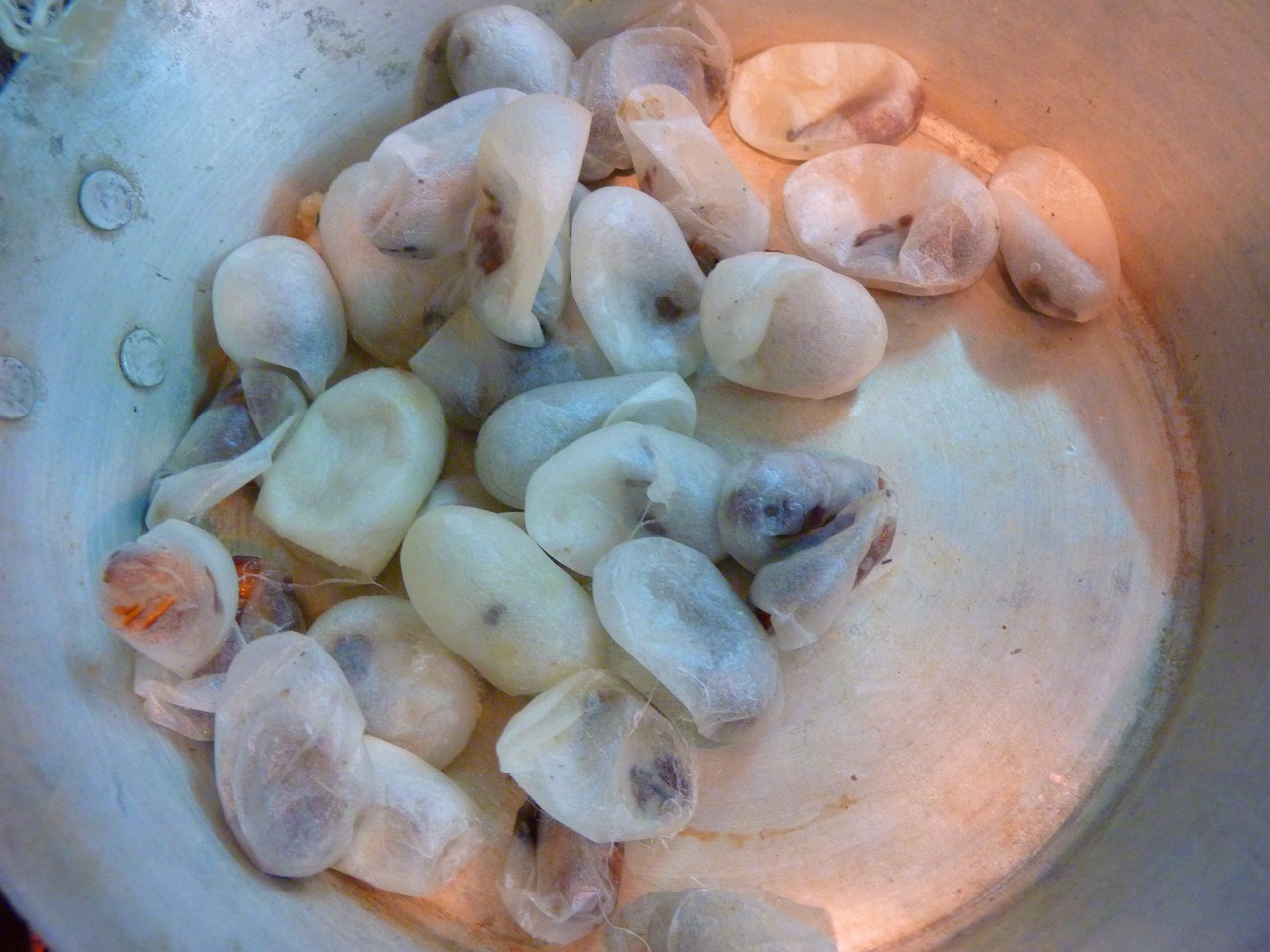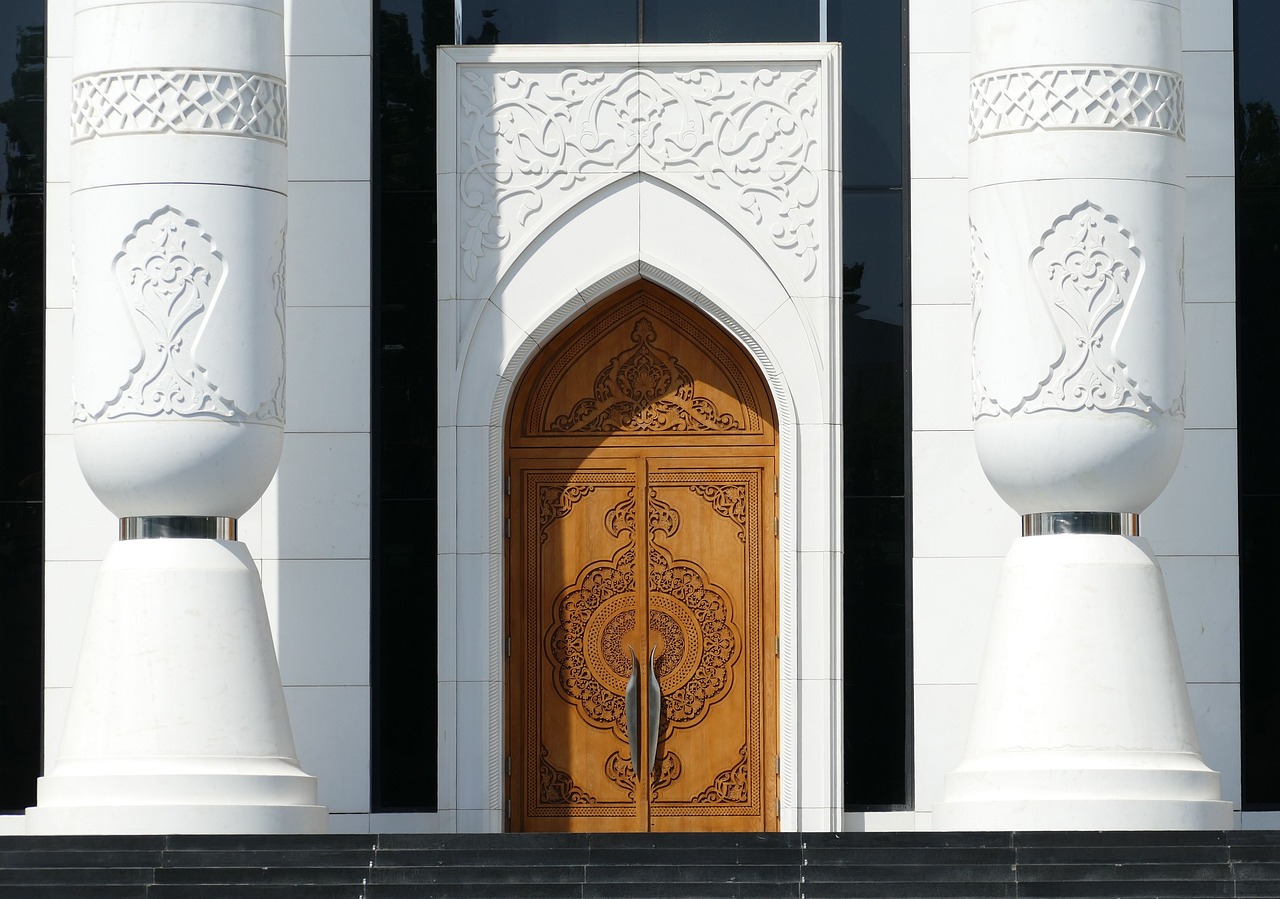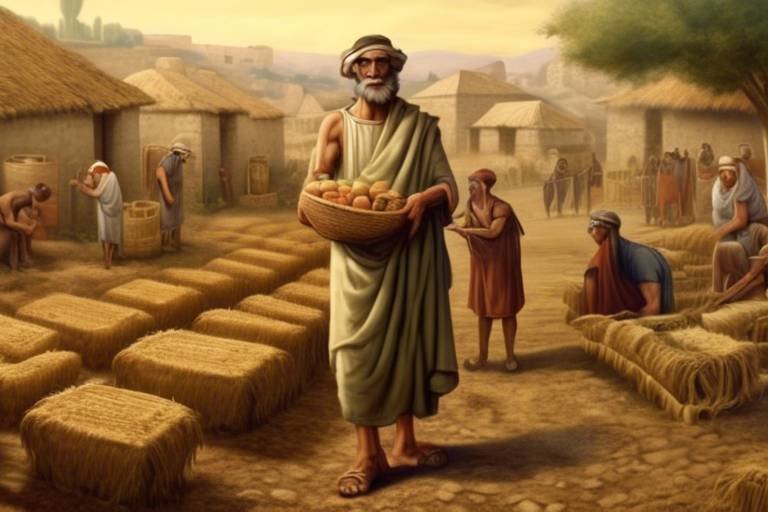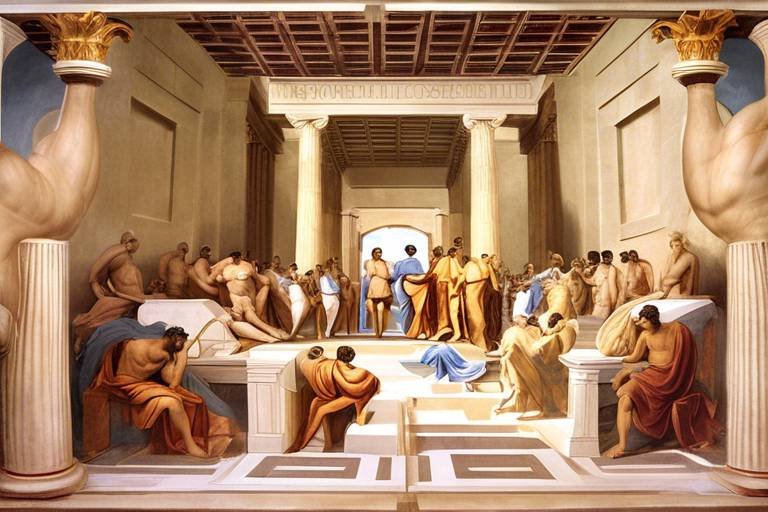The Discovery of the Silk Road - Trade and Culture
When delving into the fascinating history of the Silk Road, one cannot help but be captivated by the intricate tapestry of trade and cultural exchange that unfolded along this ancient route. The Silk Road, with its origins shrouded in the mists of time, served as a conduit for not only goods but also ideas, beliefs, and artistic expressions between the East and the West.
As traders traversed vast distances, carrying precious cargoes of silk, spices, and other commodities, they unknowingly laid the foundation for a global network of commerce that would shape the destinies of civilizations for centuries to come. The Silk Road was more than just a physical pathway; it was a bridge that connected distant lands, fostering a rich tapestry of diversity and mutual influence.
Imagine the bustling marketplaces where merchants haggled over exotic wares, where languages intermingled, and where the aroma of foreign spices hung heavy in the air. The Silk Road was a melting pot of cultures, a melting pot where ideas were exchanged, innovations were born, and friendships were forged in the crucible of mutual discovery.
Just as a single thread weaves through a tapestry, binding together disparate elements into a harmonious whole, so too did the Silk Road bind together the disparate cultures of the ancient world, creating a vibrant mosaic of human experience. The legacy of the Silk Road echoes through the annals of history, reminding us of the power of connection, the beauty of diversity, and the enduring impact of cross-cultural exchange.

Origin and Development of the Silk Road
The Silk Road, an ancient network of trade routes connecting the East and West, has a rich history that dates back to the Han Dynasty in China. The origins of the Silk Road can be traced to the diplomatic missions and trade expeditions that sought to establish lucrative commercial relationships between China and its neighboring regions. As the demand for luxury goods such as silk, spices, and precious metals grew, the Silk Road gradually expanded, encompassing diverse cultures and fostering cross-border interactions.
Over time, the Silk Road evolved into a complex web of interconnected routes, with key players such as merchants, traders, nomads, and diplomats playing pivotal roles in its development. The establishment of oasis cities and trading posts along the route facilitated the exchange of goods and ideas, creating a vibrant network of economic activity that spanned continents.
The Silk Road not only facilitated the trade of tangible goods but also served as a conduit for the exchange of knowledge, technology, and cultural practices. The transmission of ideas and innovations along the Silk Road contributed to the development of civilizations and the enrichment of cultural diversity.
As the Silk Road flourished, it became a symbol of unity and cooperation, transcending geographical boundaries and connecting distant lands. The interplay of commerce and culture along the Silk Road laid the foundation for a new era of global interaction, shaping the course of history and leaving a lasting impact on the world as we know it today.

Goods Traded Along the Silk Road
Exploring the historical significance of the Silk Road in facilitating trade and cultural exchange between East and West, shaping civilizations and economies along the ancient route.
Understanding the beginnings of the Silk Road, how it evolved over time, and the key players involved in its establishment as a vital trade route.
When delving into the goods traded along the Silk Road, one is met with a vibrant tapestry of commodities that traversed vast distances, connecting distant lands and cultures. The exchange of goods along this historic route was not merely about commerce but also about the exchange of ideas, technologies, and traditions. From the luxurious silk that gave the route its name to the aromatic spices that tantalized taste buds, the Silk Road was a conduit for a myriad of products that enriched the lives of those who traversed it.
Discussing how the Silk Road stimulated economic growth, created new markets, and fostered innovation in various industries across continents.
Examining the cultural diffusion that occurred along the Silk Road, including the spread of art, language, religion, and philosophies between East and West.
Highlighting the artistic styles and architectural marvels that emerged along the Silk Road, showcasing the fusion of different cultural influences in creative expression.
Investigating the role of the Silk Road in the transmission of religious beliefs and practices, such as Buddhism, Christianity, Islam, and Zoroastrianism, across regions.
Tracing the factors that led to the decline of the Silk Road and examining its enduring legacy on global trade, cultural diversity, and historical understanding.
When exploring the goods traded along the Silk Road, it becomes evident that the exchange of commodities was not merely about commercial transactions but also about the intermingling of cultures and ideas. The Silk Road facilitated the trade of silk, a luxurious fabric highly coveted in the West, alongside spices like cinnamon and pepper that added flavor and aroma to dishes. Additionally, technological innovations such as papermaking and compasses found their way along this ancient route, transforming societies and shaping the course of history. The Silk Road was not just a pathway for goods but a bridge between civilizations, fostering a sense of interconnectedness that transcended geographical boundaries.
Stay tuned for the frequently asked questions section!

Impact on Economic Growth
The Silk Road had a profound impact on economic growth by connecting distant regions and facilitating trade on an unprecedented scale. This ancient network of routes not only enabled the exchange of goods but also sparked economic development in various civilizations. The flow of commodities such as silk, spices, precious metals, and other luxury items fueled economic prosperity and encouraged the growth of markets along the Silk Road. Merchants and traders traversed vast distances, establishing commercial relationships that transcended borders and cultural barriers. The Silk Road stimulated the development of industries, promoted innovation, and created opportunities for economic expansion.

Cultural Exchange and Influence
When delving into the historical tapestry of the Silk Road, one cannot overlook the profound impact it had on cultural exchange and influence between the East and the West. This ancient network of trade routes not only facilitated the movement of goods but also served as a conduit for the exchange of ideas, beliefs, and artistic expressions, shaping the cultural landscapes of civilizations along its path.
Imagine a bustling marketplace where merchants from distant lands converge, their exotic wares and vibrant customs mingling in a vibrant tapestry of diversity. The Silk Road was more than just a route for trade; it was a melting pot of cultures, a meeting point where East met West and where the seeds of cross-cultural fertilization were sown.
Through the Silk Road, artistry transcended borders, with artisans drawing inspiration from diverse traditions to create unique masterpieces that reflected a fusion of styles. From intricate textiles and ceramics to ornate sculptures and architectural wonders, the Silk Road bore witness to a rich tapestry of artistic expression that blended the aesthetics of different regions.
Religious beliefs also found fertile ground along the Silk Road, as the path served as a conduit for the dissemination of faiths such as Buddhism, Christianity, Islam, and Zoroastrianism. Temples, mosques, and churches sprang up along the route, each echoing the syncretic nature of belief systems that intertwined and evolved through cultural encounters.
The Silk Road was not merely a physical passage for goods; it was a bridge that connected hearts and minds, fostering a deep sense of interconnectedness among diverse peoples. Through the exchange of languages, philosophies, and social customs, the Silk Road laid the foundation for a global dialogue that transcended geographical boundaries and enriched the collective consciousness of humanity.
As we unravel the legacy of the Silk Road, we are reminded of the enduring power of cultural exchange to transcend differences and forge connections that endure through the annals of time. The echoes of this ancient route still resonate in the vibrant tapestry of our modern world, reminding us of the transformative impact of cross-cultural encounters on shaping the fabric of human civilization.

Art and Architecture Along the Silk Road
Art and architecture along the Silk Road represent a mesmerizing fusion of diverse cultural influences, reflecting the rich tapestry of civilizations that thrived along this ancient trade route. The Silk Road served as a conduit for artistic expression, where ideas and techniques from East and West intertwined to create unique masterpieces that continue to captivate observers to this day.
One of the most striking aspects of art along the Silk Road is the blending of styles and motifs from different regions. Artists drew inspiration from a myriad of sources, incorporating elements from Chinese, Indian, Persian, and Greco-Roman traditions into their works. This amalgamation of artistic vocabularies resulted in the emergence of distinctive artistic styles that transcended individual cultures.
Architecture along the Silk Road also bore witness to this cultural exchange, with cities and settlements showcasing a blend of architectural techniques and designs. From the grandeur of the Buddhist cave temples at Dunhuang to the intricate carvings of the ancient city of Petra, the architectural marvels along the Silk Road stand as testaments to the creativity and ingenuity of the civilizations that thrived along the route.
The Silk Road not only facilitated the physical exchange of goods but also served as a conduit for the exchange of artistic ideas and innovations. Sculptures, paintings, murals, and architectural wonders traveled along the Silk Road, disseminating cultural knowledge and aesthetic sensibilities across vast distances. This cross-pollination of artistic traditions enriched the visual landscape of the regions connected by the Silk Road, leaving a lasting legacy of artistic cross-fertilization.

Religious Beliefs and Practices
The Silk Road played a crucial role in the transmission of religious beliefs and practices across diverse regions, fostering a rich tapestry of cultural exchange. As merchants, pilgrims, and travelers journeyed along the ancient route, they carried not only goods but also spiritual ideas that shaped the religious landscape of the East and West. The Silk Road served as a conduit for the spread of major world religions, including Buddhism, Christianity, Islam, and Zoroastrianism, influencing the beliefs and practices of societies along its path.
One of the most significant impacts of the Silk Road on religious beliefs was the diffusion of Buddhism. Originating in India, Buddhism spread to Central Asia, China, and beyond through the trade networks of the Silk Road. Monasteries and stupas were established along the route, serving as centers of learning and meditation for both local communities and foreign travelers. The exchange of Buddhist scriptures, art, and iconography contributed to the syncretic development of Buddhist practices in different cultural contexts.
Similarly, Christianity found its way to regions along the Silk Road, carried by missionaries and traders from the Roman Empire. Churches and Christian communities emerged in Central Asia and the Middle East, blending local traditions with Christian teachings. The Silk Road facilitated the cross-cultural exchange of religious texts, theological ideas, and artistic representations, leading to the development of unique Christian traditions in diverse cultural settings.
Islam, another major world religion, also spread along the Silk Road, particularly in Central Asia and the Indian subcontinent. Muslim merchants and scholars traveled the trade routes, establishing mosques, madrasas, and Sufi orders that contributed to the cultural and intellectual flourishing of Islamic civilization. The interchange of Islamic philosophy, science, and mysticism with other religious traditions enriched the spiritual landscape of the Silk Road regions.
Zoroastrianism, an ancient Persian religion, maintained a presence along the Silk Road, influencing the religious practices of communities in Central Asia and beyond. Zoroastrian temples and fire altars dotted the trade routes, serving as centers of worship and cultural exchange. The teachings of Zoroaster on dualism, ethics, and eschatology permeated the beliefs of diverse societies connected by the Silk Road, leaving a lasting imprint on their religious worldviews.
In conclusion, the Silk Road not only facilitated the exchange of goods and ideas but also served as a conduit for the transmission of religious beliefs and practices that shaped the spiritual landscape of the ancient world. The interplay of Buddhism, Christianity, Islam, and Zoroastrianism along the Silk Road exemplifies the profound impact of cultural interaction and religious syncretism on the development of diverse civilizations.

Decline and Legacy of the Silk Road
As we delve into the decline and legacy of the Silk Road, we uncover a complex tapestry of historical events that shaped the fate of this ancient trade route. The once bustling network of interconnected paths that facilitated the exchange of goods, ideas, and cultures gradually faded into obscurity, marking the end of an era that had profoundly influenced civilizations across the East and West.
Various factors contributed to the decline of the Silk Road, including the shift in global trade routes with the emergence of maritime trade, political instability in key regions, and the rise of new empires that sought to control trade through different means. The development of sea routes, such as the Maritime Silk Road, offered a more efficient and cost-effective alternative to the overland routes of the Silk Road, leading to a gradual decrease in traffic along the ancient pathway.
Despite its decline as a major trade route, the legacy of the Silk Road endures in the annals of history. The cultural exchanges and interactions that took place along the Silk Road left a lasting impact on the development of art, architecture, language, and belief systems in diverse regions. The fusion of artistic styles, architectural influences, and religious practices along the Silk Road created a rich tapestry of cultural diversity that continues to shape our understanding of global heritage.
Moreover, the Silk Road played a pivotal role in the transmission of knowledge and ideas, laying the foundation for the interconnected world we live in today. The exchange of technologies, scientific discoveries, and philosophical concepts along the Silk Road paved the way for future innovations and advancements, fostering a spirit of collaboration and exchange that transcended geographical boundaries.
As we reflect on the decline and legacy of the Silk Road, we are reminded of the enduring impact of this ancient trade route on our modern world. The lessons learned from the rise and fall of the Silk Road continue to inform our understanding of global trade, cultural diversity, and historical interconnectedness, serving as a testament to the power of human ingenuity and resilience in the face of changing tides.
Frequently Asked Questions
- What is the Silk Road?
The Silk Road was a network of trade routes that connected the East and West, facilitating cultural exchange and commerce between various civilizations.
- Why is the Silk Road significant?
The Silk Road played a crucial role in the development of global trade, spreading ideas, technologies, and goods across continents and fostering cultural diversity.
- What goods were traded along the Silk Road?
A wide variety of goods were exchanged on the Silk Road, including silk, spices, precious metals, ceramics, textiles, and even ideas like religions and philosophies.
- How did the Silk Road impact economic growth?
The Silk Road stimulated economic growth by creating new markets, fostering innovation, and encouraging the development of industries such as agriculture, manufacturing, and craftsmanship.
- What was the legacy of the Silk Road?
The legacy of the Silk Road includes a lasting impact on global trade, cultural exchange, and historical understanding, shaping the interconnected world we live in today.



















